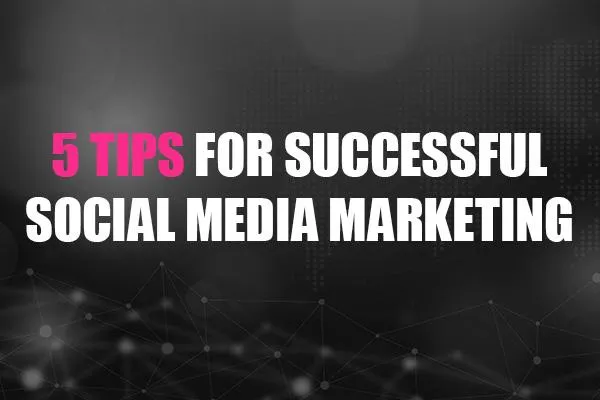Resources

5 Tips For Successful Social Media Marketing
Does Social Media Overwhelm You?
Unless you’re a superhero, it’s quite likely that you’ve found Social Media overwhelming at least once since you started your business.
Perhaps you struggled to understand how it all works and what purpose it has for your business?
Maybe you just don’t feel you have the time to give it your full attention?
Do you suffer from not knowing what to write?
Whatever the issue, you’re not alone.
Over the last decade, Social Media platforms have swelled in size and demand attention from their users on an on-going basis. They’re cleverly designed to engage and retain user attention, to keep users on the platform for longer.
What does this mean for your business?
Social Media gives you an excellent opportunity to get in front of your customers and potential customers in a variety of ways. This could be through content sharing on a website like Facebook or Twitter. It could be using video on a platform like YouTube. Or it might be more image-focused on a website such as Instagram or Pinterest.
Different social media platforms are relevant for different types of business. You need to think about the type of customers that you work with. Are you mainly offering products or services to consumers (B2C), to businesses (B2B), or both?
As there are many platforms, we’re not going to focus on everything in this one document, otherwise, it would turn into a copy of “War And Peace”. Instead, we’ll be focusing on four of the main platforms - Facebook, Twitter, Instagram, and LinkedIn. We may occasionally reference other platforms when relevant too, but our aim is to keep this nice and simple.
We’ll walk you through getting your business set up on the recommended Social Media platforms, how to brand them to your business and what sort of content you should be sharing with your audience.
Social Media doesn’t have to be overwhelming. With the right plan in place and a little bit of time each week, you can create an effective strategy that gets your content in front of your audience, so they can engage with it.
Which Platforms?
The first thing that you’ll want to do is decide which Social Media platforms you want to focus your efforts on with your business.
If your customer base is made up of business owners (B2B), you may well find that the majority of these users are on LinkedIn, which is the place to be for business to business networking and interaction.
Whereas if your customers are consumers (B2C), you’ll want to be in front of them on a platform that they use regularly. This would likely be Facebook or Twitter.
It’s worth remembering that these platforms aren’t uniform and you’ll typically find that having a profile and interacting on multiple platforms will be most beneficial for your business.
If you haven’t already, we recommend creating a business account on the following platforms:
Facebook (Business Page)
Twitter (Business Profile)
Instagram (Business Profile)
LinkedIn (Personal & Business Profile) - No need for too much focus if you’re not working with business clients here. You can use this more for engaging with new suppliers if you only deal with consumers.
Pinterest (Business Profile) - This is a great option if you offer products or services that are visual by nature.
YouTube - If you’re interested in creating videos for your audience, YouTube is the place you need to be. It’s one of the largest search engines online and videos will show in normal search engine results too.
Once you have created your accounts, you’ll want to spend a little bit of time branding them to match your business. This will typically involve adding your logo and creating an appropriate cover image.
There are some recommended sizes to use for your Social Media images. Sprout Social has a great guide here - https://sproutsocial.com/insights/social-media-image-sizes-guide/.
When creating images for your Social Media profiles, it’s important to pay attention to the recommended sizes for each platform. If you don’t stick to the recommended sizes, you will find that your images may look poor in quality or run the risk of looking stretched/cropped.
TIP: Set up your Social Media profiles and start branding them to your business. If you already have Social Media profiles, review how they look currently and check to see if you need to update any imagery. Do bear in mind that some social media platforms change the recommended image sizes when they update their designs or layouts.
What should I write?
Great question! The first thing to remember is that not every post should be a promotional effort for your business. Social Media users will switch off very quickly if all you do is advertise to them repeatedly.
There’s an old adage: “You have two ears and one mouth, use them in proportion”. This is very true with Social Media. The best value can be obtained by listening to what your target audience are saying and why they are saying it. From here, you can craft content that will resonate with your audience.
The most important tip we can share with you is that people are using Social Media for their own interests. Whilst they may “follow” your business on a particular platform, they typically didn’t load it up on their computer or mobile device just to read your latest updates.
You need to be creating content that talks about their problems, their wants, and their needs.
Your business provides products or services that solve problems for your audience. For example, you may offer a physical service such as roofing or landscaping, you may have an online store that sells camping equipment, or you may be a life coach who has a digital course.
Whatever it is that you specifically sell, your customers are purchasing your products or services based on their wants and needs. Therefore your content should be carefully crafted around this.
You don’t want to blindly post industry jargon, technical details or features. These aren’t helpful for your audience.
Instead, focus on what it is that helps your audience to make a buying decision. If you can deliver education and valuable information first, the sales conversation can follow this.
Highly valuable posts will have more engagement from your audience and you can find these shared to an even wider audience too. Sometimes you’ll find a post can go “viral” which is where it is heavily shared online.
You’re not going to always reach people who are ready to purchase from your business. This is true with any content you create or marketing activities that you carry out. Delivering education and value, whilst positioning yourself as an expert gives you the best opportunity to have future sales conversations.
TIP: Make a list of common problems that your customers typically suffer from. Think about how you can provide education and value to your audience on these topics. Remember that you can repurpose content you’ve written previously into Social Media posts.
Repurpose Your Content
One of the smartest things that you can do with your content is to use it more than once. Every piece of content that you create for your business can have more than one use.
This is known as repurposing. You’ll often hear content repurposing fall under the banner of “Content Marketing”.
Whether you’ve written a blog post, newsletter, Social Media post, recorded a video, recorded a podcast, written an article for another publication or any other piece of content… it can be used again in another format!
Here are some examples of ways you can repurpose your existing content for use on Social Media:
Blog Posts - You and your team have likely already created some great blog posts for your business. You can re-use these on Social Media either as short posts or you can take quotes from the articles and direct users to read the blog posts for more information.
Newsletters - If you send out a weekly or monthly newsletter to your audience already, take a look back through your past emails. There will be content there that you can repurpose and post on Social Media.
Brochures / White Papers - Your brochures, white papers and other publications that your business has created are ideal for taking short quotes from and re-using on Social Media. Just bear in mind that if the content is of a technical nature, you’ll want to edit it to make it easily understandable and jargon-free.
Videos - Not every business creates videos, but if you do, make sure you take clips from the videos that you create and post these on Social Media. Video engagement is typically a lot higher than a text post, so this is something that can be very beneficial for your business.
Podcasts - If you record podcasts or audio interviews, you can take snippets from these and post these on Social Media. Use a tool like Headliner to create short videos with your audio content. These will get better engagement from your followers on Social Media.
Aside from Social Media, remember that your content can be repurposed between all of these different mediums (and more). One blog post, for example, could easily be turned into a dozen social media posts, 2-3 videos, the basis for a podcast, a series of newsletter emails and more.
TIP: Review your existing content and look for content that is educational, valuable or interesting for your target audience. Plan how you can repurpose this and speed up your Social Media content creation.
Speed Up Your Process
Once you have your Social Media platforms set up and an idea about the content that you would like to post, you now need to plan your time accordingly.
Posting manually on Social Media is not the fastest method, but it’s a good way to get started. Just bear in mind that when you’re creating content for 3-4 platforms, this could easily take up 30-60 minutes of your time each day.
Luckily there are ways to speed up your process and automate your content posting.
One of our favorite tools is Buffer.This is a Social Media Management tool that will help you to plan and schedule your posts.
Using Buffer, you can connect the platforms you would like to post your content on, what time you would like your posts to appear and on which dates and then you’re all set.
Once the appropriate date/time has been reached, your content will be automatically posted to the Social Media platforms of your choice.
Buffer has a free plan which will allow you to connect 3 Social Media platforms and schedule 10 posts per social account. If you’re just starting out and you want to post once per platform, per day - this is an ideal option for you.
To get started, create a Buffer account by visiting the pricing page and clicking “Get Started” on the free plan option - https://buffer.com/pricing/publish.
After you’ve created your account, you’ll be asked which Social Media platforms you would like to connect. Buffer works with Facebook, Twitter, Instagram, LinkedIn, and Pinterest. So it should cover a number of platforms that you’d like to use for your business.
Once your accounts are set-up by following the instructions that Buffer provides, you’re now ready to start scheduling your content.
For one post per day, across 3 platforms and over 7 days - you’re looking at 21 posts in total. You can post the same post across multiple platforms, so it’s really just 7 posts with a little variation, depending on the length of the post that you create for each platform.
We’d typically expect the content creation and scheduling process to take about 1-2 hours and you only need to do this once per week, to set your business up with Social Media content for the next 7 days.
TIP: Set up your Buffer account, connect your Social Media profiles and get started with scheduling your first 7 days of posts. Set a reminder to create more posts in 6 days’ time.
Reaching More People
With the majority of Social Media platforms, you’re eventually going to come across the option for paid advertising.
This wasn’t always the ideal opportunity for every business, but as Social Media platforms have grown, they’ve started to show less and less of your content to your audience.
Facebook, for example, typically only shows your posts to around 10% of the people who follow your business page. The more engagement your posts have, the more chance they have at being seen by more of your followers.
Changes to the reach of the content you post have made advertising more a question of “when” rather than “if”. Unfortunately, many Social Media platforms are focusing on showing users posts from their friends and family, with less business content. Luckily, it doesn’t have to be too expensive to promote the posts that you create.
With Facebook, every time you create a new post on your page, you’ll have an option to “Boost” the post to reach more people. When you boost the post, you can choose to show it to a specific audience. For example, you might only want it to be visible to men and women, who are 30-40 years old and located in a specific town. There are a lot of options based on demographics and interests, as well as just focusing on people who “Like” your page already.
Once you’ve chosen a post and audience to target you can set how much you’d like to spend per day. The more you spend, the greater the number of people that you’ll be able to reach. If you’re just starting out $1-2 per day for a period of 7 days, will allow you to start seeing some data for a relatively low cost.
Now you can finalize your boosted post and get started. If this is your first time creating a boosted post or advert, Facebook will ask you for some additional information to create your advertising account. For example, they need your business details and your payment information.
After this, your boosted post will be “in review” for a short period of time and then set live to a wider audience.
This is just one simple example of paid advertising on Social Media, there are many more. You should save boosting opportunities for your best content. If you’re not sure which content is your best, look for posts that are getting a lot of likes and engagement.
The best content to boost is content that serves your business well and aligns with your goals. Ultimately you’re trying to make more people aware of your brand, and as you get further into advertising you want to encourage users to visit your website. Once they do this, you’ll be able to target them with further advertising, known as “retargeting”.
TIP: Try boosting your first post after you get some good engagement on Social Media. Look for posts that serve your mission and goals, and also educate your audience well. Don’t boost a simple post that doesn’t fit your mission statement.
Are You Ready To Get Social?
As you can see, getting started on Social Media is very easy. It’s free to create accounts and if you have a graphic designer on your team, you can brand your profiles quickly. If you don’t have a graphic designer, you can hire someone to assist for a relatively low cost.
Content is the most important part of your Social Media marketing campaigns. Whether you’re writing posts, creating a video, using audio clips, paying for advertising or more - the quality of the content you create is going to directly correlate with engagement and performance.
It’s a good idea to keep an eye on your biggest competitors. Look at how they are using Social Media and what sort of engagement they are getting from their followers on the various platforms. If you spot a competitor who is getting a lot of engagement, think about why this is and how you can emulate their success.
Big corporations have whole teams of people who manage their Social Media accounts. It’s a big thing for them to easily stay in touch with their audience. By utilizing tools and optimizing the use of your time, you and your team can replicate this type of success, without taking time away from other important business activities.
The best way to learn more about Social Media is to take action. Why not start getting your profiles set up today and planning out the content that you’d like to post? If you have been active with blog posts or other content previously, you’ll find it even easier to get started as you can repurpose your existing content.
In the meantime, view our social media campaign to schedule posts for the year.

We focus on both acquisition and retention marketing so that our clients can keep their existing customers while also attracting new ones.
Navigation
Contact Us
info@smartwebplans.com
Mon-Fri: 10AM-5PM
954-932-5330
© 2025 Smart Web Plans, LLC - All Rights Reserved.


